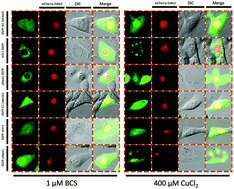Functional characterization of copper transporters zCtr1, zAtox1, zAtp7a and zAtp7b in zebrafish liver cell line ZFL†
Abstract
Copper (Cu) is an essential element for all organisms, serving as an enzyme cofactor to maintain cellular activity and vitality. However, Cu homeostasis must be maintained at the physiological and cellular levels as Cu ions can be highly toxic. In mammals, ATP7A is expressed in most tissues, but relatively lower expression is found in the liver, and is responsible for the intestinal uptake of Cu, while ATP7B is highly expressed in the liver, kidneys and placenta, and is responsible for removal of Cu in the liver. CTR1 and ATOX1 are responsible for cellular Cu uptake and intracellular Cu transport, respectively. Here, using a zebrafish liver cell line (ZFL), we studied the cellular functions of four zebrafish Cu transporters. In zebrafish, zAtp7a is expressed mainly in the liver and zAtp7b is expressed mainly in the intestines, different from that of humans which have a high ATP7b level in the liver and high ATP7a level in the intestines. We here found that zctr1 or zatox1 overexpression increased Cu accumulation in ZFL cells. Moreover, zctr1 overexpression made ZFL cells more sensitive to Cu and Zn exposure, and overexpression of zatox1 or zatp7b increased Cu uptake and Cu tolerance in ZFL cells. Overexpression of zatp7a made ZFL cells more sensitive to Zn. Taken together, our findings suggest that zatp7b is responsible for Cu export despite its expression level being much lower than zatp7a in ZFL cells.



 Please wait while we load your content...
Please wait while we load your content...